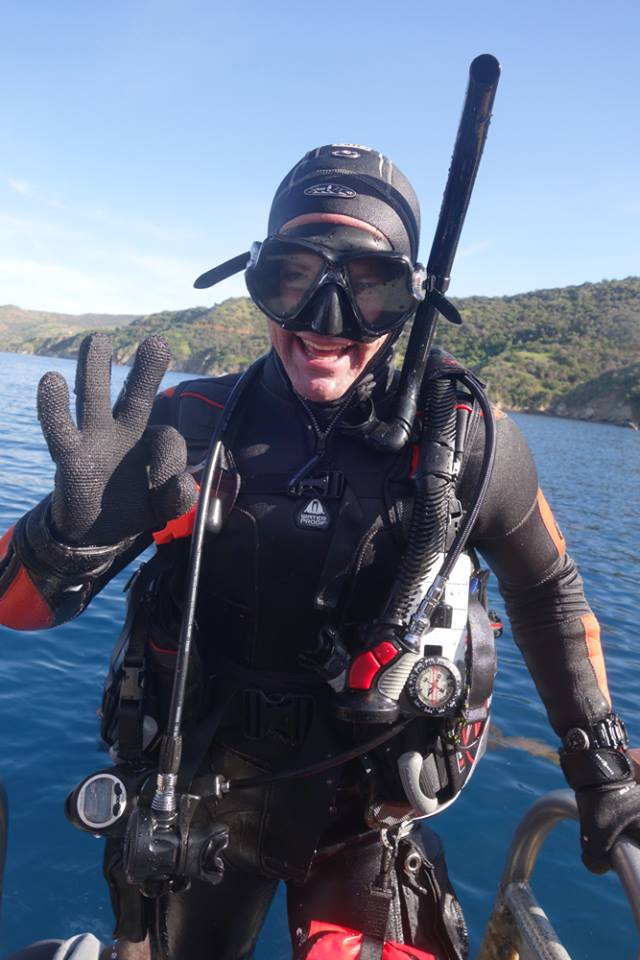
Dan Stephens
Dive Master
Location: Agoura Hills
Hometown: San Diego
Hi, I am Dan Stephens and I started diving with Ocean Safari in 2014, I had already had my Open Water certification from another agency, but was hoping to continue my Advanced certifcation with NAUI. After meeting and talking with Gabe I was hooked. I knew right away this was the place for me. Since then I have taken many classes at Ocean Safari, but more important than anything else, I have made so many friends here. Gabe has challenged me in so many ways and I always have come away a better person/diver than I was before. My true love is writing about my adventures and sharing what I have learned. I look forward to one day having a chance to dive with you. Cheers, Dan
Blue Caverns Chamber Day, January 26th, 2019
January 27, 2019
I got up this morning at 4:00 am to go down to San Pedro and get on the boat we were taking out diving on this day, this would be my first dive trip of the year and I was very excited. We were to do two dives around “Blue Caverns” then head over to the USC Catalina Hyperbaric Chamber. The boat we would be on was the “Bottom Scratcher” and we would be diving a “live boat” since we would not be dropping an anchor in this “no anchoring area”. Blue Cavern is in close proximity to Big Fisherman Cove which is where the Catalina Hyperbaric Chamber is on the west end of Catalina Island.
Why sign up for a two dive trip? I have always been one of those divers who believed that time underwater was like racking up points under my dive belt, but now that I am maturing in my diving I have found that some of our greatest learning experiences are out of the water, hence this month’s CPR class and this Chamber trip. Being a better diver isn’t how many dives you do, but really understanding dive theory and physics, understanding navigation and how to handle diving related emergencies, that all is learnt in the classroom environment then applied to the trips.
Why are chambers so important anyway? I will explain this more in the diving sense rather than the medical sense since you are all divers. The purpose of the hyperbaric chamber, which is also called the diving decompression chamber, or recompression chamber is to treat diving related injuries and of course certain medical conditions. The Catalina Chamber treats air embolisms, decompression sickness and carbon monoxide poisoning. The first two of which are obvious to divers but the third, maybe not so. Think of carbon monoxide poisoning as this, a boater maybe working on his engine out at the islands in the confined space of his boat and may inhale carbon monoxide, he then passes out because the carbon monoxide has bonded to his red blood cells which travel to his brain and heart. This poisoning can be very serious and he would need medical attention immediately. Carbon monoxide can also be the result of a bad air fill in a scuba cylinder, this has happened once to me on a shallow dive and the experience was not one I wish to happen again. The pressurized oxygen in the chamber can break the bond of the CO molecule from the red blood cell thus respired out of the body. The chamber environment is perfect for such therapy.
The diving conditions off California can be tough, cold water, strong currents wind and waves all can precipitate decompression sickness, especially on those days when the water is cold and the sun is out. These such days we are often suited up in 7 mil suits, in between dives in cold water and before you know it you become dehydrated. I am amazed that the chamber averages just one patient per month, it shows that the industry is doing well educating divers how to avoid the mysterious onset of DCS. There is still much more to learn and scientist are willing to admit this. The Catalina chamber covers an area from Dana Point to Ventura and out. Most patients come to the chamber through dive boats, the US Coast Guard and the Baywatch. The Catalina chamber has treated a wide range of people, from divers to movie set actors, from boaters to people inhaling carbon monoxide for whatever reason. In all since the opening of the chamber in 1974 they have treated over 1,100 cases.
Let’s run through a simple scenario of what it looks like to treat a diver suffering decompression sickness, better known as the bends. Why do they call it the bends? Well the pain of having nitrogen bubbles in the joints caused divers to bend over in pain not only that, but bubbles could lodge near the spinal cord nerves and cause paralysis. The goal for the chamber is two-fold to decrease the size of the bubbles so small so that they can be exhaled out the lungs and to get oxygen to diffuse the nitrogen in the blood stream while nourishing damaged tissues of the organs.
So, ok we got it so far, now what does it look like? The diver is brought in via dive boat or helicopter while breathing pure oxygen. He or she is then brought into the chamber and taken down or pressurized to a depth of 165 feet on regular air, 78 percent nitrogen and 21 percent oxygen. Then the chamber attendants will slowly bring the diver to a depth of 60 feet, which is known as the treatment depth. At 60 feet the attendant who is with the diver inside the chamber will put a bibs mask on the diver which will supply pure oxygen. The diver will breathe pure oxygen at 60 feet for 20 minutes. After which he or she will go back to breathing air for 5 minutes. Depending on the severity of the “hit” the diver may continue this schedule alternating 20 minutes of oxygen and 5 minutes of air. When the diver’s condition improves he or she will be brought up to 30 feet while still alternating oxygen and air. As their condition further improves the diver will be brought slowly back to the surface. Treatments such as this can range from 4 and half hours to twelve hours and over a number of days until recovery. This is just a simplified example as it was explained to us, as there are different schedules depending on the kind of hit the diver takes, but, it is a good general idea of how it works.
This kind of treatment can save a diver’s life and is crucial for us as divers to understand. It can happen to any of us, at any time. Decompression Illness is still not fully understood in fact to cite Richard E. Moon MD, FACP, FCCP, FRCPC, Des F. Gorman MBChB, MD, PhD, in Physiology and Medicine of Hyperbaric Oxygen Therapy, 2008: “About 900 cases of DCS are reported yearly in the United States among recreational scuba divers. Most accidents occur in inexperienced divers. The incidence of DCS for recreational divers is 1 per 5000 to 10,000 dives, and for commercial divers, one incident per 500 to 1000 dives. Up to 50% of cases of DCS occur in divers who claimed to have been diving within the limits set by a standard table or decompression computer.” Even though the chances of taking a hit are small we still need the assurance of a chamber being there for us. The Catalina chamber is staffed 365 days a year twenty four hours a day, mostly by volunteers and a few permanent residents. They are truly dedicated individuals that could potentially make up the team that save our lives or the lives of loved ones. We need to support their continued operation, and attending Chamber days is a good way to do just that.
Ocean Safari provided this educational experience which I am grateful for, in fact this past month the focus of Ocean Safari has been on dive safety. This winter time training will make us better responders in the following months as the 2019 season picks up. Thank you Gabe, Thomas, Andy and the rest of the Ocean Safari team you all have made me a better and smarter diver. Cheers, Dan





























